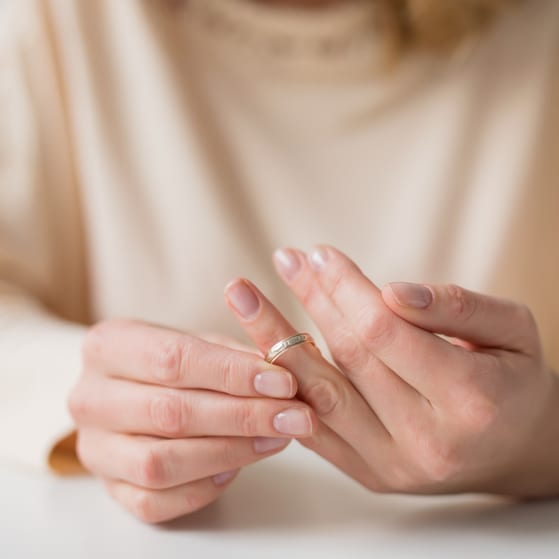A total of 41 lawyers have been promoted across the firm including Rachel James and Richard Rigg who have become part of our almost 100-strong partnership.
Read moreThe real reason we’re seeing a decline in domestic abuse applications — Mel B and the Family Court system
12 min read

The latest statistics suggest that we’re seeing fewer domestic violence applications at the Family Court. Is this because less abuse is happening?
As family lawyers, we know that many parents who’ve experienced domestic abuse and turn to the court system to protect themselves and their children find the legal process traumatic — including former Spice Girl ‘Mel B’, who’s teaming up with the charity Women’s Aid to call for change.
Here, we explore the real reason behind the decline and asks — is the Family Court fit for purpose?
Mel B and Women’s Aid vs the Family Court
After reading a recent edition of Today’s Family Lawyer, I couldn’t help but notice the juxtaposition between two articles that referred to domestic abuse and violence. One was entitled “Court can be as bad as the abuse itself” in relation to former spice girl Melanie Brown (aka Mel B), a campaigner for victims and survivors of domestic abuse. The other referred to the latest family law statistics, claiming that there has been “a decline in domestic violence applications”.
If you read the first article, you’ll know that Mel B is using what she says is her own damaging experience of the family court system to launch a petition alongside Women’s Aid for the judiciary to undergo formal, compulsory and ongoing training in relation to domestic abuse. The important point to note here is that this training must come from the experts, such as Women’s Aid.
The petition further calls on the Government “to implement the recommendations of the Harm Panel Report”. This refers to the findings made by an expert panel and explains how effective the family courts are at identifying and responding to allegations of domestic abuse and other serious offences. It assesses the risk of harm to children and parents in private law children proceedings, where separated parents can make applications for the court to decide childcare arrangements — including which parent a child should live with and how much time they should spend having contact (if any) with the other parent — as well as whether or not any safeguards should be put in place to protect parents and children from harm (or the risk of harm).
On the back of the Harm Panel Report, the Domestic Abuse Commissioner has called for “wide reaching reforms” to the Family Court, stating that “over 80% of legal practitioners surveyed felt that the Family Court is likely to retraumatise victims and survivors of domestic abuse” and that “victims and survivors… describe how allegations of domestic abuse are minimised during proceedings”.
The Mel B article further mentions that “60% of child arrangement cases in England and Wales feature domestic abuse — yet many judges don’t understand and call it ‘parental conflict’”. This comment struck a particular chord with me, as I've experienced this in my role as a family lawyer. I've seen many CAFCASS (Children and Family Court Advisory and Support Service) welfare reports and comments from the judiciary that refer to 'parental conflict'. While this is understandable where it follows on from a difficult breakdown in a relationship or marriage, where’s the line between 'parental conflict’ and more serious forms of abuse?
Could this be the reason why we’re seeing a decline in ‘domestic violence’ applications?
The power and control wheel — 12 examples of domestic abuse
While writing this article, I’m sitting next to a poster provided by a counsellor that refers to the ‘Power and Control Wheel’. This refers to 12 specific examples of different types of abuse, coercion and control. It’s something that I use regularly when speaking to clients to identify whether they’re experiencing (or have experienced) abuse in their relationship or marriage.
These are listed as:
- Emotional abuse — blame game, invalidating feelings, guilt tripping, jealousy, withholding affection, silent treatment, stalking, threatening.
- Intellectual abuse — mind games, demanding perfection, making you feel stupid or inferior, attacking ideas or opinions, manipulating information, saying you’re crazy.
- Financial abuse — limiting access to or controlling money, being made to account for every penny spent, closing bank accounts, not paying child or spousal maintenance, creating debt.
- Pets and property abuse — killing or threatening to kill pets, punching walls or furniture, throwing things, damaging your vehicle, smashing and breaking things.
- Psychological abuse — threatening suicide, threatening to kill you or others, displaying weapons, making light of the abuse, denying that they’ve said certain things, intimidating actions or gestures.
- Physical abuse — blocking exits, driving at excessive speed, locking you out of the house, physically hurting you, choking and restraining.
- Verbal abuse — name calling, swearing, shouting, insulting, being sarcastic or condescending.
- Sexual abuse — threatening to or having an affair, forcing sex, sexual put-downs, criticising your appearance, withholding sex, making comparisons to others, demanding sex as payment.
- Spiritual abuse — criticising your faith, restricting access to places of worship, using faith to their advantage, using scripture against you.
- Using children — abusing children, threatening to harm or remove children from your care, refusing to make child maintenance payments, belittling you in front of children, using access or contact with children as leverage.
- Social abuse — being isolated from family and friends, monitoring phone calls or mileage, using tracking devices, controlling who you can see or speak to, preventing you from working.
- Using culture — using culture as an excuse for abuse, criticising your culture, forcing you to adopt cultural practices, not allowing you to participate in mainstream culture.
These 12 examples help me to steer a client’s case in the right direction for presenting to the court if they’ve experienced abuse that could potentially (whether directly or indirectly) cause emotional, physical and/or psychological harm to a child, too.
Every family lawyer appreciates that all children have a right to a relationship with their parents and wider family members, so long as it’s safe to do so. If there’s abuse, this can lead to safeguarding issues — and appropriate measures must be implemented until there’s no risk of abuse.
How does the Family Court tackle cases that involve domestic abuse?
Currently, if allegations of domestic abuse, violence, coercion or control are raised by a parent in private law children proceedings, the court — at the start of the case and before anyone attends the first hearing — must give consideration to Practice Direction 12J. This defines domestic abuse and lists the types of behaviours that may be exhibited by abusive parents. It also refers to the general principle that domestic abuse is harmful to children and can put a child at risk of harm — whether it’s children who are victims themselves or have witnessed a parent being violent or abusive to the other parent and are living in a home where abuse is perpetrated, even if they’re too young to be fully aware of what’s going on. Children can suffer from direct physical, psychological and/or emotional harm from living with and being victims of domestic abuse. They can also suffer indirectly where the abuse impairs the parenting capacity of one or both parents.
The Direction further sets out which steps must be taken throughout the proceedings to deal with these allegations and how these can impact on childcare arrangements. A ‘finding of fact’ hearing, for example, is usually considered, as well as whether the allegations need to be tried. This is where the parties give written and verbal evidence and are cross-examined in relation to the allegations and counter allegations (if made), before a Judge decides whether to make a finding of fact in relation to each allegation.
If domestic abuse is found, the court must consider what measures will help if there’s to be contact between the abuser and child. For example, is assistance needed from a social worker, psychiatrist or psychologist? Is an assessment needed and further report required from one of these types of professionals? The court will also assess whether the abuser (and the victim or child) needs treatment or another form of intervention to prevent them from inflicting further abuse and remove the risk of harm to the other parent or child.
Before contact can be ordered by the court, it must be satisfied that the physical and emotional safety of the child and parent that the child lives with will be secured (so far as possible) before, during and after contact. It must also be satisfied that the parent with whom the child lives will not be subjected to further domestic abuse by the other parent.
If contact is ordered, the court must look at whether certain conditions should be imposed to help safeguard the child and other parent. This can include whether there should be direct or indirect contact, whether contact should be supervised (and by whom) and how often contact should take place (as well as the duration and whether this should be for a specified period of time). The court can look at reviewing the arrangements over time to see how things are working out.
In terms of what protections the court can offer when parents have to attend court hearings and give evidence, victims of domestic abuse are automatically eligible for special protective measures in private law family proceedings. The court will determine whether special measures will help the party to participate and improve the quality of evidence that they can provide. Such measures can include giving evidence from behind a screen or even in a separate room via video link so as not to look at the other party or be in the same courtroom as their abuser.
Are we seeing a decrease in domestic violence applications?
The Government recently released figures that showed an 8% decrease in the number of domestic violence applications and a 6% decrease of orders made in relation to domestic violence between January and March 2024 when compared to the same period of time in 2023.
There are questions as to why the Government only released figures for these three months, rather than looking at a much longer period of time — which may not show the same trend of decline. The data also can’t be a true representation of the real number of cases where domestic violence and/or abuse is apparent and protection is needed, since much work still needs to be done to educate victims on recognising the signs of domestic abuse and — most importantly — to understand and accept that it isn’t okay to remain in an abusive relationship.
Yet it seems likely that another explanation could link back to Mel B’s comments — that for some, experiencing the court system and the way in which domestic abuse is handled can be as bad an experience as the abuse itself. If victims of domestic violence — especially if abuse is mental or verbal, rather than physical — find it hard to provide evidence, aren’t confident that they’ll be believed and have abusers that may be skilled in the art of deception and manipulation, it’s unsurprising that many choose to remain silent. Some may also fear being triggered by having to recount traumatic events, undergo cross-examination and be made to feel as though they aren’t telling the truth.
What else could be done to support those in court who have experienced domestic abuse?
While the Court has tried to implement some methods of protection in terms of offering separate rooms, erecting screens and using video links when evidence is being given to avoid coming into contact with the abuser, you have to wonder if anything more can be done.
Not so long ago, during the COVID-19 pandemic, all hearings were dealt with remotely via platforms such as Microsoft Teams. This meant that hearings could be conducted from home, which might make a survivor of domestic abuse feel safer and more comfortable, especially if they have permission for someone in support to sit with them during the hearing (so long as that person adheres to the rules — that they don't interfere with the evidence being given and that the contents of the hearing remain private at all times).
The other option is to attend the offices of their solicitor or barrister to support them while the hearing takes place remotely. Both these options avoid the risk of the survivor coming into direct contact with the abuser in the public areas of court or even outside on the way in or out of court where there's little protection that can be offered.
If the hearing must take place inside a court building, it would be ideal if the court could provide a duty counsellor or domestic abuse support worker to offer support to those who've experienced domestic abuse or violence and are dealing with applications at court that involve the abuser. However, this will all come down to Government funding and/or the resources available from domestic abuse charities that could offer this type of support at court during hearings. While resources and funds are limited, allocation could be reconsidered to protect the most vulnerable.
Sensitive family lawyers and experts in domestic abuse cases
Our award-winning family team contains solicitors with vast experience in cases where clients have been subjected to domestic abuse and violence, including by individuals with narcissistic personality traits and coercive and controlling behaviours.
If you’ve suffered from any form of abuse in your relationship or marriage and need our advice and expertise, please fill out our contact form below, send us an email or give us a call on 0333 004 4488 to arrange a confidential conversation.
Our lawyers can guide you through the options available and offer practical guidance and a supportive ear to help protect you and your children.
Talk to us
Loading form...
Related insights
When it comes to managing a settlement agreement project, it's invaluable to have specialist solicitors acting on both sides. They can be instrumental in ensuring a fair, efficient and legally sound resolution.
Read moreThe Supreme Court has clarified the law surrounding when ‘non-matrimonial property’ can become ‘matrimonial property’.
Read more

